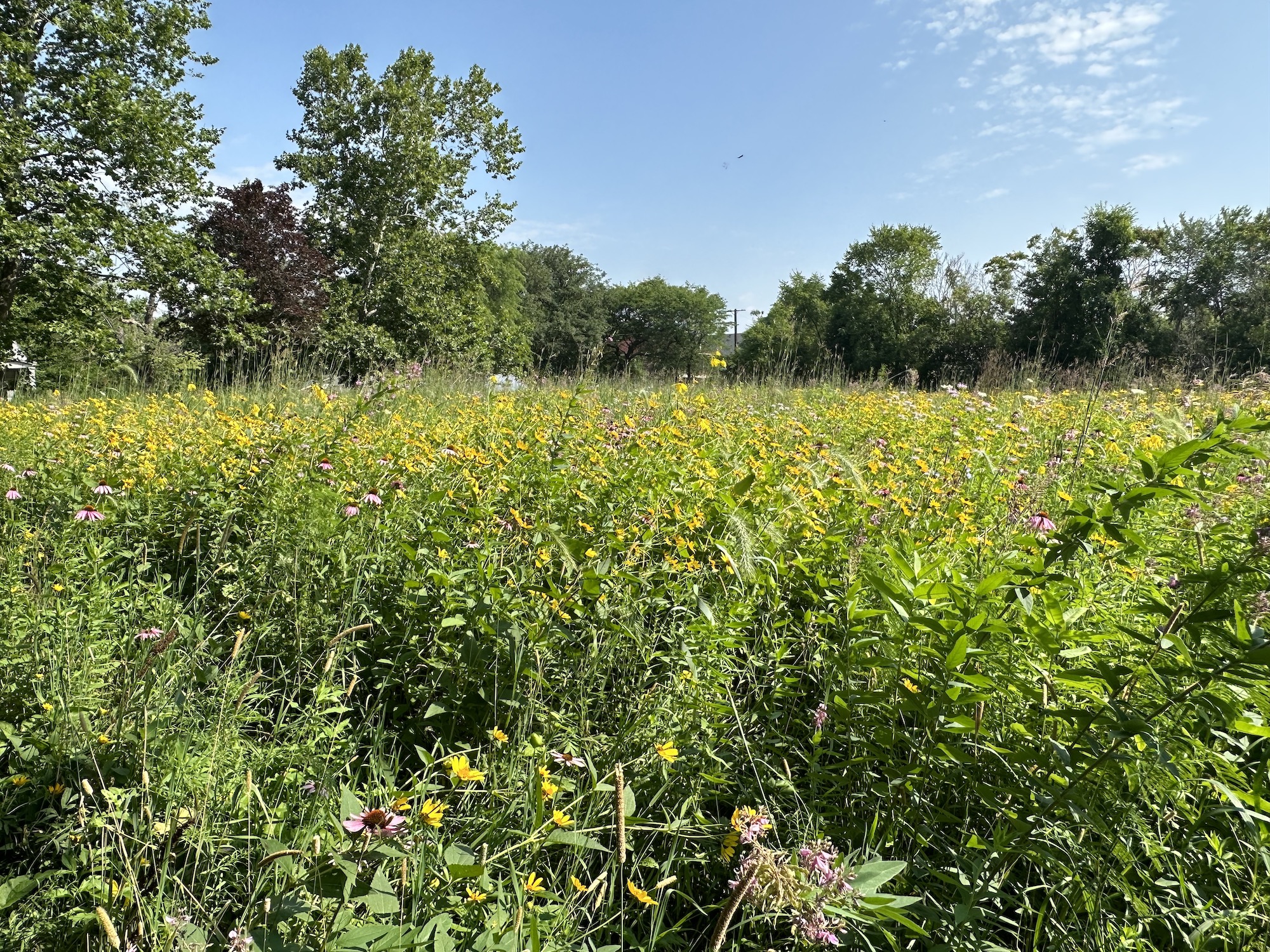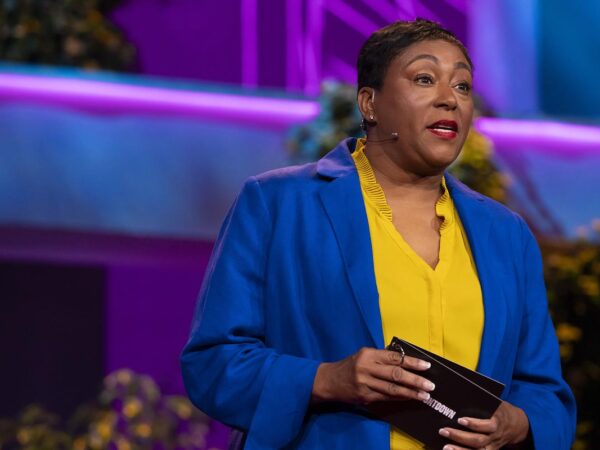
This article was republished here with permission from Planet Detroit.
By Jenny Sherman, Planet Detroit
Detroit resident Andrew “Birch” Kemp has planted trees in Detroit’s Poletown East neighborhood for over 20 years.
By expanding the city’s tree canopy, the former Detroit high school teacher hopes to promote the growth of healthy, resilient and equitable green spaces in his community that would both enrich his and his neighbors’ quality of life and deepen their connection to nature.
“There was a time in Detroit when if you wanted to see the riverfront, you had to climb through a hole in the chain link fence underneath Cobo Hall,” Kemp, who now serves as executive director of the nonprofit Arboretum Detroit, told Planet Detroit. “We literally had to break the law to go see the river and sit with the water.”

Andrew “Birch” Kemp, executive director of Arboretum Detroit, addresses tour attendees from the “stumpscape” inside Circle Forest, one of the organization’s latest native restoration projects in Detroit’s East Ferry Warren neighborhood. (Photo by Jenny Sherman)
But today, things are changing. Long-vacant lots are being repurposed into green spaces, pocket parks, backyard gardens and farms by community groups and residents. The City of Detroit has been slowly but surely growing its network of trails, including its nationally renowned RiverWalk spanning 3.5 miles along the Detroit River — which will extend to Belle Isle this fall — and trails like the Dequindre Cut, Southwest Greenway and the future Joe Louis Greenway that connect neighborhoods and provide broader access to green spaces.
“The whole fabric of the city is changing because of the park systems we’re creating,” Kemp said. “We’re circumventing not just the streets, but the automobile itself.”
But there is still much work to be done. According to The Trust for Public Land, just 6% of Detroit’s land area is dedicated to parks – compared to the top 100 most populous cities in the U.S., which have a national average of 19%. That leaves much room for improvement in a city with roughly 19 square miles of vacant land, according to Sarah Hayosh, director of land use and sustainability at Detroit Future City (DFC).
“We think that open space is really important to have thriving resilient neighborhoods,” Hayosh said. “Natural areas, green stormwater infrastructure, productive uses like urban agriculture, solar, buffers from industry and highway as well as parks and recreation…those are all important typologies for a sustainable open space network.”
Through DFC’s Working with Lots Program, the nonprofit has supported implementing more than 50 open space projects throughout Detroit neighborhoods, working in step with community leaders like Kemp to facilitate them and obtain funding.
A recent Parks & Resilient Neighborhoods tour on Detroit’s east side, organized by the Detroit Parks Coalition in partnership with DFC and the East Ferry Warren Community Association, showcased a handful of those projects.
Among the tour stops were the Chandler Park Marshland, stewarded by the Chandler Park Conservancy; a native meadow in Callahan Park established by Detroit Audubon; Arboretum Detroit’s multi-lot native restoration projects in the East Ferry Warren neighborhood; and Field Temple, a green space being cultivated with Buddhist principles.

Educational outreach and community engagement has been a cornerstone of every greenspace project in the East Ferry Warren neighborhood, with Arboretum Detroit, Detroit Audubon and Detroit Future City frequently collaborating on programming. (Photo by Jenny Sherman)
“So many of these community green spaces, they’re a labor of love for residents, and often operating on very low budgets, so there’s a lot of grassroots engagement and volunteer effort,” said Hayosh. “And that all takes collaboration.”
Over the past five years, the marshland, rain gardens, and bioswales installed at Chandler Park keep nearly 2.5 million gallons of stormwater from entering the city’s sewers and provide valuable habitat for birds, turtles, amphibians, insects and other wildlife. An overflow valve and recirculating pump system diverts water from neighboring roadways, helping to reduce street flooding, basement backups, and sewer overflows to the Detroit River.
Approximately $1.5 million has been spent to develop the marshlands, Alex Allen, president and CEO of the Conservancy, told Planet Detroit, with funding coming from the Kresge Foundation, Erb Family Foundation, National Fish & Wildlife Foundation and the City of Detroit. A total of more than $8.5 million has been put towards park improvements, planning, activities and educational programming.
“It’s come out to be a nice place for people just to relax, enjoy and hopefully learn a little bit about nature,” Allen said. “We have environmental science classes through our summer camp so kids can learn about stormwater management.”

Previously decommissioned by the city, Callahan Park on Detroit’s east side has been transformed into a thriving four-acre meadow over the past three years, with 39 different native flowers and six native grasses planted by Detroit Audubon. (Photo by Jenny Sherman)
Callahan Park, a city-owned but unmaintained and under-utilized park in the East Ferry Warren neighborhood, has been transformed over the past three years into a thriving four-acre meadow, with 39 different native flowers and six native grasses planted. The park is the first of Detroit Audubon’s Detroit Bird City parks, community greenspaces created to support ecological functions, including wildlife habitat, stormwater capture, carbon sequestration, and air and water pollution mitigation.
More than 100 species of birds have been recorded at the park since the project began.
“Every year, the biodiversity increases a little bit with more species that we’re seeing,” Ava Landgraf, conservation and research coordinator for Detroit Audubon, said. “It takes about three years for a meadow to establish and look nice and full and full of flowers.”
After three years of mowing back the meadow to prevent the spread of invasive species and encourage the establishment of native species, she said very minimal intervention is needed, as fully established meadows require far less maintenance than a turf grass lawn. In 2022, after receiving positive feedback from the community, the Callahan meadow was expanded another two acres into an adjacent lot.
Just down the street from Callahan Park are Arboretum Detroit’s restoration projects, Circle Forest and Oxygen Alley — at 3301 E. Palmer St. and 5361 Moran St., respectively. A grantee of DFC’s Working With Lots program and recipient of a National Fish & Wildlife grant, Circle Forest sits on 12 vacant lots – about the size of a football field – that were neglected and used as a dumping ground for years.
“The first thing we did was take out 60 yards of trash; it was just a mess,” Kemp said. “But once we got volunteers in here and started cleaning it up, we realized it was really an honor and a privilege to clean up the land. It’s a very good feeling.”

Tour attendees were encouraged to explore the space at Circle Forest, which had unique features like a “stumpscape” and log raft mandala, as well as functional features like benches, walkways and a “critter path.” (Photo by Jenny Sherman)
So far, Arboretum Detroit has planted more than 200 native species in Circle Forest with the help of volunteers and community support, as well as adding functional features like benches and walkways and more unique visual features like a “stumpscape” and log raft mandala.
Oxygen Alley sits on four abandoned lots across the street from the bird park that have been transformed into a greenway lined with trees, wildflowers and benches that connects the neighborhood from east to west.
Named in honor of the closing of the Detroit Trash Incinerator earlier this year, a major polluter in the city for more than 30 years, Oxygen Alley has been planted with air-filtering trees and aims to make the neighborhood more resilient by providing a shaded space for residents to enjoy.
Another recipient of DFC’s Working With Lots program, and the last stop on the Parks & Resilient Neighborhoods tour was Field Temple, located on the east side of Elmwood between Kirby and Frederick streets.
Led by Sarah Addae Pizzimenti, the greenspace and tea house is used for meditation, classes, retreats, and training in Buddhist philosophy. Meditations are held at the temple at 10 a.m. every Sunday year-round, with a walking path and forested space for contemplation, meditation and celebration.
Hayosh said DFC has contributed to the project beyond its grant programs, from hosting community discussions and educational programming to assisting community groups and residents with securing outside grants or purchasing lots from the Detroit Land Bank Authority.

Limestone stormwater basins, or ponding basins, have been installed along the perimeter of Chandler Park to help reduce street flooding and sewer overflows. (Photo by Jenny Sherman)
“It takes a lot of sweat equity to make these neighborhood projects happen, and there’s a lot of incredible neighborhood leaders who spearhead this work, but they need a whole backup team at the outset,” said Hayosh. “And also to keep the projects going and sustained over time because they take a lot of maintenance and care.”
Kemp said the city remains ripe with opportunities for grassroots projects, and with a network of support and resources from local organizations, creating a project of your own is more accessible than ever.
“There are lots in your neighborhood, I promise you, that you can steward and make something beautiful,” says Kemp. “So if you do have the juice and want to connect with us or each other, please go for it.”
Catch more news at Great Lakes Now:
Michigan bald eagles soar back from near-extinction
Michigan tribes fight long odds to restore wild rice, their history
Featured image: It takes about three years for a native meadow to establish itself, according to Ava Landgraf, conservation and research coordinator for Detroit Audubon, with very little intervention needed after that. (Photo by Jenny Sherman)




